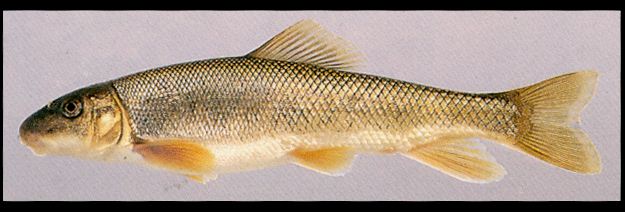Southeastern populations of the white sucker, Catostomus commersonnii (Lacepede), occur in pool areas of tiny to moderate-sized streams that are often intermittent. They are often associated with spring habitats in the Tennessee River drainage. White suckers have smaller scales than other suckers, and are a mottled olive or gray dorsally with scale rows faintly marked by horizontal streaks. Males often develop a copper to red midlateral streak during spawning activity as well as large breeding tubercles on rays of the anal fin and lower lobe of the caudal fin. These tubercles are widely scattered in a single row on each fin ray. Large single tubercles also occur on the edges of the lower caudal peduncle scales. Juvenile white suckers have four diffuse dark blotches (parr marks) along the sides.
Size: can reach a total length of over 2 feet and over 5 lb. in Tennessee streams and lakes; world angling record 3.3 kg (7.24 lb.) from Wisconsin.
Color: mottled olive or gray dorsally with scale rows faintly marked by horizontal streaks; lower sides and belly white.
Fins: dorsal fin rays 10-13; anal fin rays 7 (6-8); pectoral fin rays 16-19; pelvic fin rays 9-11
Lateral-line scales: 60-70 in Tennessee specimens; 53-85 elsewhere.
Gill rakers: 22-24.
Vertebrae: 45-48.
White suckers spawn in early spring over gravel areas in lakes or streams at water temperatures of about 10 C. (50 F.). Some individuals return to the same spawning areas year after year. Males congregate over the spawning area, and several of them press against the sides of receptive females when they enter the area. Spawning is most active during dusk and dawn. Females spawn about 30,000 eggs that are randomly scattered over the substrate.
Young white suckers feed primarily on zooplankton, while adults feed on benthic invertebrates, especially midge larvae, amphipods, and snails. Stomach analyses of white suckers from Tennessee streams indicate an average composition of 50% benthic invertebrates and 50% unidentified organic and inorganic matter, probably incidentally ingested (Starnes. and Starnes. 1981). Growth rates of white suckers and age at sexual maturity are quite variable (Beamish 1973). Specimens from streams in Tennessee become sexually mature at about 300 mm (12 in.) total length or less, and specimens over 500 mm (20 in.) total length are uncommon. There are a few reservoir populations in Tennessee that may attain greater size.
The white sucker, Catostomus commersonnii, is common in the upper portion of Abrams Creek, and was collected in the lower portion of Abrams Creek and its embayment during the 1957 reclamation. It is rare in Little River, absent from the Little Pigeon River, and infrequently found in the lower portions of Cataloochee Creek (Pigeon River system), Oconaluftee River, and Deep Creek and Twenty-mile Creeks of the Little Tennessee River system (Simbeck 1990).
References:
Beamish, R. J. 1973. Determination of age and growth of the white sucker (Catostomus commersoni) exhibiting a wide range in size at maturity. J. Fish. Res. Bd. Can. 30:607-616.
Etnier, David A. and Wayne C. Starnes. 1993. The Fishes of Tennessee. University of Tennessee Press. Knoxville, Tennessee.
Jenkins, Robert E. and Noel M. Burkhead. 1994. Freshwater Fishes of Virginia. American Fisheries Society. Bethesda, Maryland.
Simbeck, Damien J. 1990. Distribution of the Fishes of the Great Smoky Mountains National Park. Master of Science Thesis, University of Tennessee.
Starnes, L. B. and W. C. Starnes. 1981. Biology of the blackside dace Phoxinus cumberlandensis. Amer. Midl. Nat. 106:360-371.
Animalia
Chordata
Actinopterygii
Cypriniformes
Catostomidae
Phenology


